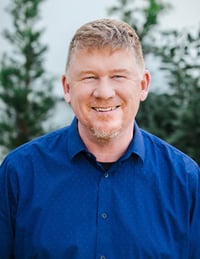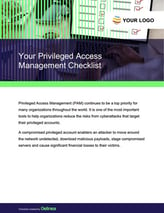A self-proclaimed nerd falls in love with technology, cybersecurity, and Delinea

As part of our interview series with Delinea’s leaders, we talked with Chief Product Officer Phil Calvin. Phil leads the product, engineering, and support teams that build Delinea software. He’s a veteran of the tech industry, including almost a decade at Salesforce.
Phil shares his management strategies and product philosophy, plus the ups and downs of his personal journey as a tech nerd and the importance of doing something you love.
Q: When did you discover your love for technology?
I've been building software since I was around 10. Here’s how much of a nerd I was: A computer magazine called Compute printed the source code for a Commodore 64 font editor and I wanted to try it out. But, because I was 10, my mom only got me the Commodore Vic 20, which was the baby version. So, I somehow figured out how to write a font editor for the Vic 20, which actually worked.
I sent it to the magazine to try and get it published and they sent it back with a rather condescending letter because I’d forgotten one major feature of the font editor—the ability to save fonts. So, ok, I'd forgotten a feature, but I was only 10! That was the start of my nerd career.
Q: What is it about your job now that gets your heart pumping?
I love the challenge of really tough technical problems, scaling people and teams, and delivering it all with a focus on customers and quality. It’s incredibly complicated, but it's massively rewarding.
I've been a nerd my entire life. I've hacked into every system and I've played around with all of the various networking stacks and applications and seen almost everything there is to see on every possible system.
I've been involved with the protocols and systems that secure enterprises for my entire career. I was always involved with the gory details of networking and permissions and enterprise software and the management of things.
I have a deep understanding of the problems that Delinea customers are dealing with because I’ve lived it. I understand the problem, whether the customer is trying to secure a network or an Active Directory deployment, or they've set up an Amazon VPC and need to figure out how to administer it.
Q: What are the essential qualities you’re building into your product team and the Delinea product – the qualities that make customers fall in love?
The most important thing that we do as the product team is develop quality software. It doesn't matter what else we do if our software doesn't work. Quality is a very broad topic to me. It's not just about software bugs. It's how secure our software is. It's the user experience.
For people to love us, we need to be easy to understand and use. Every customer is dealing with an explosion of environments and they’re inundated with a million things. It's so hard for customers to understand what they should do. I walked around RSA and I was astonished at the number of acronyms we throw at our customers. It's actually insane.
So our goal is to make people’s lives easier, and yes, fall in love with our technology.
Our product must be consumable by IT professionals that aren’t security experts.
I have a very strong bias towards an integrated platform approach and bringing that seamlessness and simplicity into a robust set of functionalities.
Q: How do you build those muscles to ensure that quality and seamlessness?
It's easy to say quality is the #1 priority. It's a different thing to operationalize.
There isn't a group of people over in some office that just, you know, beats quality into the product. You have to build quality into your DNA from the very beginning. You can allow shortcuts only if they don’t impact quality.
As a mechanism to prioritize, I use a framework called “V2MOM” that came from my time at Salesforce. It stands for: Vision, Values, Methods, Obstacles, and Metrics. Everything we do is viewed and measured through that lens and it outlined the things we want people to do in the order to them.
We have several V2MOMs. In addition to quality, we’ve been bringing Thycotic and Centrify products together as one Delinea, we’re investing for the future with our new platform, and we’re enhancing the current product suite. That's the priority order we consider to work on, and it's not a linear list. You don't go from top to bottom.
Q: How have you built a successful marriage of two industry-leading product organizations?
Because we had been two companies, we essentially had nine different product teams that all operated with their own systems, scales, and ways of doing things. The danger with that is that the experience for the customer is disjoined. For a company in super growth mode, that’s not scalable.
A term we used at Salesforce is “don't ship your org chart,” which means that it doesn’t matter if different internal teams contributed different parts, the product should look like it came from one company.
So, we had to bring multiple high-performing teams into one development methodology. Instead of organizing along product lines, we now have four pillars: Platform, Vaulting, Authorization, and Edge. And we’ve created a tight working relationship across support, engineering, and product. Thanks to a rich set of dashboards, we know where we are with our Service Level Agreements at any given time. Now we can build a platform that functions as an integrated system and position Delinea for the future.
Q: What advice do you have for folks who hope to take on a leadership position like yours one day?
I think the most important thing to be a successful leader is honestly caring about the success of your people. If you care, then no matter your leadership style, you’ll be able to help coach them and steer them. It's a monumental difference.
The second thing is to have curiosity beyond what you do, because the higher up the organization you go, the less you live in an org chart. What I mean by that is, you can’t just care about your product or your function or your business unit. You need a curiosity beyond your immediate boundaries. And the last part is to do something you love. I absolutely love building software. I love the technical part of it. I love the people part of it. I love the challenge part of it. If you love it, you’ll do your best work.

FREE CHECKLIST
Need a step-by-step guide for planning your strategic journey to privileged access security?


